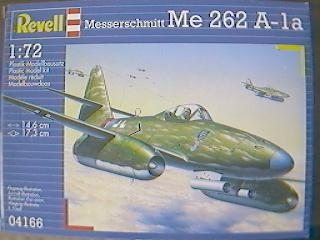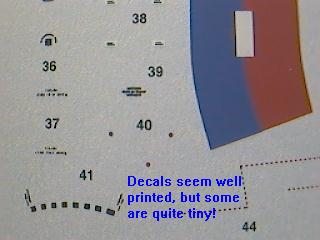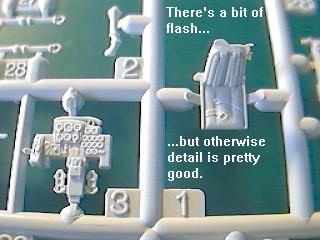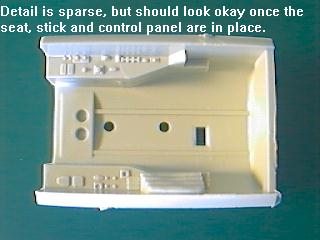
|
KIT: |
Revell 1/72 Me-262A-1a |
|
KIT # |
4166 |
|
PRICE: |
$8.00 |
|
DECALS: |
Two Aircraft |
|
REVIEW & |
Ron Guerra |
|
NOTES: |
` |

|
HISTORY |
History: The Messerschmitt Me-262 was Germany's first jet fighter produced in quantity, with over 1400 being constructed. Its top speed of 540 mph (870 kph) and 4 30mm cannon gave the aircraft performance and firepower far ahead of many contemporary machines. Variants were used as bombers, 2 seat nightfighters and unarmed recon machines. One type even mounted a single 50mm cannon to be used against bomber formations. While quite vulnerable on takeoff or landing to prowling Allied fighters, the 262 was nearly untouchable in the air and it claimed over 100 Allied aircraft before the end of the war. However, due to fuel shortages and other problems, it was never fielded in sufficient numbers to be much of a threat to the Allied forces or to the overall state of the war. Some copies of the 262 were built by Avia as the S-92, and were being used into 1950 by the Czech Air Force.
|
THE KIT |
This model kit of the Me-262 A-1a from Revell of Germany is copyright 1997 and comprises 5 sprues of 56 parts (2 unused) featuring recessed panel lines. RoG has several other versions of the 262 including an unarmed photo-recon and a nightfighter.
The instruction sheet features a short history in German and English, as well as a single black and white photo of the completed kit. There is a parts map and you'll note that 2 clear pieces aren't to be used with the A-1a. The usual warning information is presented in about 500 languages (actually, 18), takes up 3 pages and includes the sometimes odd and vague-sounding advice to "Store chemical toys out of reach of young children", to "Wash hands after carrying out activities" and not to "swallow material". The instructions also mention you'll need 20 grams of weight to place in the nose of the model, otherwise you'll have a tailsitter. Color information is given for Revell paints, though some RLM numbers are also provided. I'll leave it up to the Luftwaffe experts to decide if those colors are correct.

 The sprues are all packed in one
poly bag, including the canopy. However, it's so thick that it seems it'd be
pretty hard to damage it, but more about the canopy later. The decals seem well
printed and are in register, but there are no swastikas. Aircraft stenciling is
extensive and most of the decals are very small, so applying them will take some
time and patience. 12 decals alone make up the wing walk lines.
The sprues are all packed in one
poly bag, including the canopy. However, it's so thick that it seems it'd be
pretty hard to damage it, but more about the canopy later. The decals seem well
printed and are in register, but there are no swastikas. Aircraft stenciling is
extensive and most of the decals are very small, so applying them will take some
time and patience. 12 decals alone make up the wing walk lines.
All the parts except for the 1 piece canopy are cleanly molded in light gray. There is very little flash on any of the kit parts except for a few pieces, notably a small amount (easily removed) on the kit seat as well as on the canopy.
 The main
and nose gear wells are pretty bare and the main gear wells may not be quite
deep enough. The main and nose gear legs are nicely detailed, though they may be
a bit thick. The mail wheels have 2 very obvious ejection pin marks, but are
otherwise nice looking. The tread on the nose wheel tire seems a bit overdone.
The nose wheel itself is a separate piece from the nose gear leg, so this will
make painting easier. To assemble the model with its landing gear extended,
you'll need to cut apart the gear doors. However, because I like to display my
aircraft models in the air (where they belong), I'll building my 262 with its
gear up. I'm very pleased that RoG has produced some of these newer kits with
the option of wheels up or down. Why can't all the other kit companies out there
do this???
The main
and nose gear wells are pretty bare and the main gear wells may not be quite
deep enough. The main and nose gear legs are nicely detailed, though they may be
a bit thick. The mail wheels have 2 very obvious ejection pin marks, but are
otherwise nice looking. The tread on the nose wheel tire seems a bit overdone.
The nose wheel itself is a separate piece from the nose gear leg, so this will
make painting easier. To assemble the model with its landing gear extended,
you'll need to cut apart the gear doors. However, because I like to display my
aircraft models in the air (where they belong), I'll building my 262 with its
gear up. I'm very pleased that RoG has produced some of these newer kits with
the option of wheels up or down. Why can't all the other kit companies out there
do this???
 Externally,
detail is pretty nice. For the most part, the panel lines are clean and straight
and there is rivet detail where appropriate. The engine pods are well detailed
overall. It shouldn't be too much trouble to deal with the engine pod-to-wing
attachment, as dry fitting doesn't show any horrible gaps. There are some minor
depressions to be filled on top of the pods immediately in front of the wing
though. Because the kit fuselage parts are obviously also used to make the 2
seater version, a separate upper fuselage part is used in the single seater
model to cover up the rear-seat cockpit opening. The loop antenna on the
fuselage spine is much too thick for the scale, as are all the other antennas
and the pitot tube. There are no provisions for separate flaps or other control
surfaces. The gun camera aperture in the tip of the nose is there, but the
cannon ports will need to be drilled out. Some of my references show small
bulges in the middle of the gun bay panels, but these bulges are not included in
the kit. Opened shell ejection ports are represented under the nose.
Externally,
detail is pretty nice. For the most part, the panel lines are clean and straight
and there is rivet detail where appropriate. The engine pods are well detailed
overall. It shouldn't be too much trouble to deal with the engine pod-to-wing
attachment, as dry fitting doesn't show any horrible gaps. There are some minor
depressions to be filled on top of the pods immediately in front of the wing
though. Because the kit fuselage parts are obviously also used to make the 2
seater version, a separate upper fuselage part is used in the single seater
model to cover up the rear-seat cockpit opening. The loop antenna on the
fuselage spine is much too thick for the scale, as are all the other antennas
and the pitot tube. There are no provisions for separate flaps or other control
surfaces. The gun camera aperture in the tip of the nose is there, but the
cannon ports will need to be drilled out. Some of my references show small
bulges in the middle of the gun bay panels, but these bulges are not included in
the kit. Opened shell ejection ports are represented under the nose.
The under-nose racks are optional, as well as the choice of either fuel tanks or air-to-air rocket tubes. The rocket tubes are 4 pieces each. I can't find any pictures of 262's carrying this type of weapon, but they seem to be similar to the Wgr. 21 air-to-air rockets carried by some other German fighters, like the FW-190 and BF-109. The history in the instructions mentions that the 262 carried R4M rockets under the wings, but they are not provided in the kit.

 Moving inside now, the cockpit
tub has some sidewall detail, but not much. The instrument panel features raised
instruments and molded-on rudder pedals. The control stick seems a bit thick.
The seat has very faint texture detail on the padding and the belts are all
molded in place. Some of my few references show an armored headrest on the seat,
but the neither kit nor the painting on the box top represents this. Curiously,
the bottom of the cockpit tub as well as areas on the insides of the fuselage
halves feature more detail than the inside of the cockpit itself. However, these
areas will be completely hidden from view when the model is assembled. Perhaps
on the real aircraft these areas were visible from below through the main gear
bays. Unfortunately, the main gear bays on the model are not open to the inner
fuselage.
Moving inside now, the cockpit
tub has some sidewall detail, but not much. The instrument panel features raised
instruments and molded-on rudder pedals. The control stick seems a bit thick.
The seat has very faint texture detail on the padding and the belts are all
molded in place. Some of my few references show an armored headrest on the seat,
but the neither kit nor the painting on the box top represents this. Curiously,
the bottom of the cockpit tub as well as areas on the insides of the fuselage
halves feature more detail than the inside of the cockpit itself. However, these
areas will be completely hidden from view when the model is assembled. Perhaps
on the real aircraft these areas were visible from below through the main gear
bays. Unfortunately, the main gear bays on the model are not open to the inner
fuselage.
The only real disappointment with the kit is the canopy. Frankly, it's pretty bad. It's thick, distorted and the framing is incomplete towards the rear. Compared to the rest of the kit, it's quality is poor and is probably best replaced by an aftermarket source.
On the whole, $8 is pretty reasonable for this kit, considering the overall quality. Superdetailers will always find more to do, especially in the cockpit and wheel wells, but aside from finding a new canopy, I'll be building this straight from the box.
May, 2001
|
REFERENCES |
David A. Anderton -- "Aggressors Volume 3: Interceptor Vs. Heavy Bomber", Zokeisha Publications Limited, 1991
David Donald (editor) -- "German Aircraft of World War II", Motorbooks International, 1996
Bill Gunston -- "The Illustrated Directory of Fighting Aircraft of World War II", Salamander Books Limited, 1988
Editor's Note: This is virtually the same as the ProModeler kit previewed recently. The main difference is the boxing, decals and instruction sheet.
If you would like your product reviewed fairly and quickly by a site that averages over 2,600 visits a day, please contact me or see other details in the Note to Contributors.